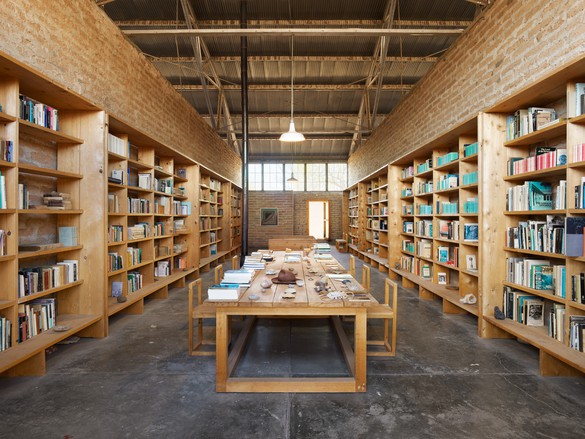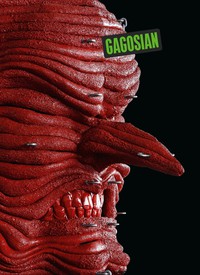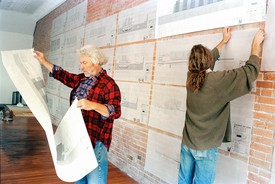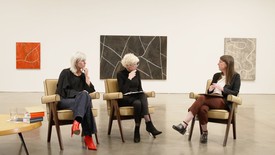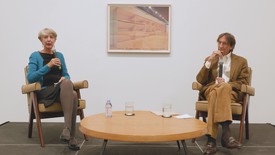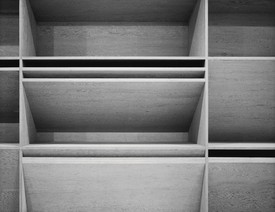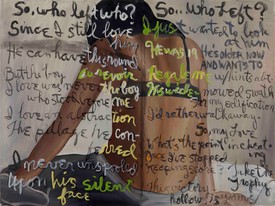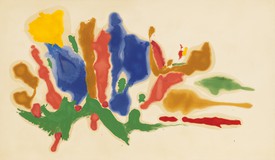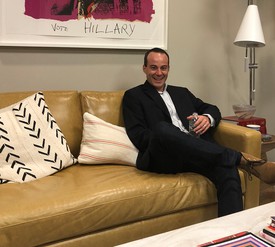
Caitlin Murray is the director of archives and programs at Judd Foundation, where she has worked since 2008. She is the coeditor of Donald Judd Interviews (2019), Donald Judd Writings (2016), and The Present Order: Writings on the Work of Ian Hamilton Finlay (2011). Murray is the coowner of the Marfa Book Company and of 300 South Kelley, a gallery in Marfa, Texas.

Richard Shiff is Effie Marie Cain Regents Chair in Art at the University of Texas at Austin. His recent book Sensuous Thoughts: Essays on the Work of Donald Judd collects his various writings on the artist over a twenty-year period. For Gagosian he recently wrote “Haunting,” a text for the catalogue of David Reed’s exhibition of new paintings in 2020.
Caitlin Murray One of the distinctive aspects of the Judd Foundation Archives is its location. Unlike archives in libraries and museums, often far from the artist’s work, in Marfa you see Judd’s archive in the context of his work. This is rewarding for scholars but creates difficult questions, archivally speaking. For example, in addition to the materials housed in the Judd Foundation Archives in Marfa, some archival items—drawings, for example—remain installed in Judd’s living and working spaces. These drawings aren’t works on paper per se, but they’re significant in their reflection of Judd’s thinking. It’s been an interesting process for us to determine what remains on view and what should be moved into an archival setting, where these items can be more easily and safely studied.
Richard Shiff Do you run into situations where you don’t know whether what you have is an archival document or a work of art?
CM Yes, certainly, especially with drawings. We’re working toward understanding this with more clarity. Right now, the idea is to leave things as open as possible and to treat drawings as a study collection of the Archives, a kind of hybrid space between the art collection and the Archives. What we’d like to explore is the variety of the drawings—which Judd sold, which were framed, which went on exhibition, which were left in situ, which were stored among project files or intermixed with correspondence—to get a better sense of how to proceed. It’s a process that necessitates conversations with studio assistants, gallerists, art historians. Additionally, there was a retrospective exhibition at the Kunstmuseum Basel in 1976 that included drawings from Judd’s early sketchbooks—the last major exhibition of Judd’s drawings, interestingly—and because that exhibition happened within Judd’s lifetime, I think it tells us a lot about what he thought about his drawing practice.
RS You mean because he had a hand in saying “These are worth displaying”?
CM Yes, exactly. But still, many challenging questions remain. For example, the drawings from Judd’s early sketchbooks aren’t signed or dated. Also, it seems that Judd only removed pages from his bound sketchbooks, or framed them, when they were included in an exhibition; he appears to have kept them together as a way to reflect on a crucial period in his development as an artist, the period in which he began making works in three dimensions.
The Archives also contain drawings that, from a drafting standpoint, are more finely articulated—in pen as opposed to pencil, for example. A number of these are dated and signed, and you see these out in the world—they’re drawings that he would have sold or given as gifts.
RS These are finely rendered schematic drawings of particular works?
CM Yes. And the Archives also contain drawings related to his architectural practice. Not all of these were made by Judd: he commissioned drawings by the architects Lauretta Vinciarelli, Adrian Jolles, Claude Armstrong, and Donna Cohen. Their collections are now part of the Judd Foundation Archives.
RS On the question of determining whether something is a document or a work of art, one thing I think of is that Judd thought like an architect and worked like an architect. He made a lot of sketches of ideas and possibilities: What would it look like this way? And what would it look like this other way? He could very quickly sketch it out, and then you have something that might look like a throwaway drawing yet embodies a lot of thought. Then you have to decide, how much is thought worth as a component in art?
CM Recently we were photographing a group of drawings. In this case all of them related to architectural projects, but they were reflective of Judd’s general drawing practice in their size and style—quickly drawn ideas, as you’re saying, not presentation drawings. In some instances the paper is stained or ripped. There are different ways of thinking about the value of those drawings. As one example, there’s their value to Judd, who kept drawings and artwork that he made at quite a young age, as well as his notes from when he was studying art history and philosophy at Columbia.
RS Yes, that concern for documenting his own evolution is a remarkable feature of Judd.
CM It’s fascinating that he kept so many of these documents, and that he kept them in the spaces where he was living and working many years later. I think you could even say they were part of his studio practice. These are documents that he was reflecting back on to generate new work; they’re not just relics of the past.
RS He’s someone who kept all of his thought alive, all of his aesthetic notions over the years.
CM Exactly. For those who are stewarding Judd’s legacy or want to know more about his life and work, the Archives and this special case of drawings are exceedingly significant. If the work itself is the primary documentation, the drawings are extremely close to it, because you can see in them the working out of ideas. And it’s rare to have documentation that you can then triangulate with extensive correspondence from the time—correspondence with dealers and gallerists and other artists.
RS And the third term is the space, right?
CM Right. These spaces that Judd created, both in New York and in Marfa, are the third element of that triangle.
RS He’s probably not alone in this respect, but it’s certainly significant that when he dated sketches of ideas, he included the location along with the date.
CM In his writing practice, too, he would note where he took down the note, be it at Spring Street or in Marfa or in Europe.
RS He was extremely sensitive to the location wherever he was at a given time.
CM Right. In the library at the Block, for example—another special case, in that it exists within an installed space and contains around 13,000 volumes—Judd would occasionally write in a book where and when he bought it.
One interesting thing that we’re looking at right now, which relates to Judd’s desire to keep his thought present, is his art writing, which dates from between 1959 and 1965. As you know, Judd wrote hundreds of reviews during that time, and in addition to showing the development of his thinking, they’re an important record of what was on view in New York in that period. His papers include well over a thousand pieces of exhibition ephemera that he gathered, and a significant number of these have notes that he presumably made as he walked through the exhibitions. So we have the ephemera and Judd’s notes; handwritten drafts of the articles and essays; the typed drafts, with corrections; and the published versions. And we’re able to see his thought process all the way through. It’s really very special.
RS For me as a scholar, everything you’ve organized in the Archives is extremely valuable. There’s a lot that I’ve never seen, I’m sure, and that I have no inkling of, but the things that I do have an inkling of, like the drafts for the more important essays, are extremely important. Then also the occasional sketch that represents the kind of “aha” moment where he’s not just saying, It could be this way, it could be that way—he’s saying, It should be this way.
We don’t know exactly what’s going to be important to art historians in the future, certainly, so making this material available is key.
Caitlin Murray
CM There’s still a lot of material yet to be discovered for us as well. We’re embarking on a two-year project to complete the processing of Judd’s papers, which will help us to complete an effort that’s taken many years of work. The papers are extensive, including many hundreds of boxes of published and unpublished writings, correspondence, photographs, moving-image material, drawings, exhibition ephemera, publications, and museum, gallery, and exhibition files. The goal is accessibility. We don’t know exactly what’s going to be important to art historians in the future, certainly, so making this material available is key. In that we’re in the process of organizing Judd’s papers, the research time and materials available are limited, and access will expand as we complete processing.
One of the most rewarding research experiences for me, outside of the publications we’ve been able to produce using materials from the Archives—such as Donald Judd Writings [2016], Donald Judd Interviews [2019], and Donald Judd Spaces [2020]—was to support the research of the curatorial team for Judd, the retrospective exhibition at the Museum of Modern Art, New York, in 2020–21. That was an extensive, multiyear research process that involved every part of the Foundation’s holdings.
I wonder, Richard—in several of Judd’s essays he talks about the work of Barnett Newman, Mark Rothko, and Jackson Pollock, and how at the time of those artists’ deaths, their work was scattered and it became increasingly difficult to see it, especially to see multiple paintings at one time. That seems to have made an incredible impact on Judd as a young artist. I’m wondering how those statements struck you, or how you see them in relationship to Marfa, to the Chinati Foundation, and to Judd’s own archival endeavors.
RS Well, Chinati was his project to make sure that what had happened to Newman and Rothko didn’t happen to him, and to John Chamberlain and Dan Flavin and whoever else he would eventually have decided to display in depth. He had an unusually ambitious sense of himself and he extended that to the artists he appreciated in his generation. It all became a single project, and it could not have been done by a person who did not have great faith in his own importance and in the seriousness of his own work. The Archives reflect that seriousness, because he did keep things—meaning that there could be a future for people who wanted to think the way Donald Judd thought, or at least wanted to understand the way Donald Judd had been thinking.
All sorts of questions become possible when you’re able to see things together. . . . the drawings, the material studies, the works, the spaces, the library—they form a whole.
Caitlin Murray
CM When he conceived of Judd Foundation, in 1977, Judd wrote, “The purpose of the foundation is to preserve my work and that of others and to preserve this work in spaces I consider appropriate for it.” Separately, he said of his spaces in New York and Marfa, “Almost as much thought has gone into the space surrounding the work as has gone into the work itself.” That raises interesting questions about the role of thought as a determining factor in Judd’s art, and about the importance of his papers and their location.
RS Yes, it’s something I wanted to get to, that the only thing that prevents it from being art is that we have this categorical distinction. You know, there’s visual stuff and there’s stuff you make that has a material presence and there’s the thought that goes along with it. But the thought, we usually say, is not the art.
Just recently there was the wonderful Cezanne drawing exhibition at the Museum of Modern Art. A lot of the drawings were in sketchbooks, where it’s clear Cezanne was exploring ideas. Some of the pages are carefully constructed, but a lot of them are really casual; there are some very beautiful drawings, and then there are some trivial pages. But it’s drawing, and it’s in the sketchbook, so it’s automatically a work of art. With regard to the Judd Foundation Archives and this question, Are these drawings or works of art?, if you were to take all the drawings for a particular project—not one by one, but all together—it seems to me that it’s like a Cezanne sketchbook: it’s a work of art because it’s a package of thought, and the thought is expressed in these visual diagrams.
Then you have to decide, how much is thought worth as a component in art?
Richard Shiff
CM I totally agree. All sorts of questions become possible when you’re able to see things together. That’s even present in the way Judd organized his working spaces, with tools alongside drawings alongside photographs alongside material samples and completed artworks. When everything is visible, you’re likelier to understand the questions that were being asked at a given time, and perhaps you can produce an idea that’s whole rather than just a part of a thought, which is of course so central to the formal qualities of Judd’s work. These elements—the drawings, the material studies, the works, the spaces, the library—they form a whole.
Judd’s papers would of course still be valuable if they were at a large collecting institution with many other artists’ papers, and there would be benefits to that: they could be studied alongside other artists’ archives, and that’s important in that it encourages different questions. But if you were to remove Judd’s archive from Marfa, from its adjacency to his work, and all of these other modes of his thought and interests, I think something important would be lost.
RS I agree with you, because, as you’ve said, that sense of place was so important to him. He was a beautiful nineteenth-century anarchist or utopian, you know, creating a total society and organizing this town in a beneficial way. It’s really very utopian.
CM And at the same time, he wasn’t searching for something that wasn’t here and bringing it here; he was creating from what already existed. He was working with locally made adobe bricks, with easily purchasable pine two-by-fours, with native plants.
Of course we know that Marfa is remote, and can be hard to reach for our colleagues in other parts of the country and the world. It’s important that we do our best to provide access to the Archives remotely. But people doing in-depth research really have to come here to visit the Judd Foundation and the Chinati Foundation. I think being here, using the Archives and visiting Judd’s spaces, will generate new ideas and thinking for a long time to come. I think, too, that the Judd papers attest to how much more there is yet to discover, even for an artist who has had a significant amount of recognition. Whether it’s learning about his engagement with astronomy at Texas’s McDonald Observatory, or about his political activities, or reading his correspondence with other artists, these constellations of activities are significant and for generations of artists will allow for new ways of connecting his life and work.
I think when one is steeped long enough in Judd’s work, his way of living, and his interests, one sees a way of understanding the world in terms of its materiality. And with Judd, the scope is so grand. When people say, Wow, you’ve worked on one artist for thirteen years, I think to myself, But with this artist, there’s still so much there.
RS It’s like working on Leonardo. With certain people, you don’t run out of interest.
